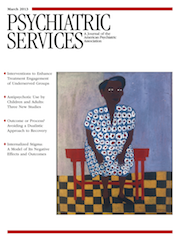Public Stigma Associated With Psychosis Risk Syndrome in a College Population: Implications for Peer Intervention
Abstract
Objectives:
This study compared stigma associated with the psychosis risk label and diagnostic labels for nonpsychotic and psychotic mental disorders among young adult peers.
Methods:
Urban college respondents (N=153) read an experimental vignette describing a young adult experiencing prodromal symptoms who was randomly assigned a diagnostic label (major depression, generalized anxiety disorder, schizophrenia, or psychosis risk with and without accurate information about the psychosis risk label) and answered questions about stigma toward the individual in the vignette.
Results:
Compared with labels for nonpsychotic disorders, schizophrenia elicited more negative stereotyping and the at-risk label invoked greater social distance and less willingness to help. Any increased social distance appeared to be reduced by accurate information about the at-risk state. No differences in stigma were found for the psychosis risk and schizophrenia labels.
Conclusions:
The psychosis risk label alone appeared to evoke greater status loss and discrimination. Accurate information may minimize some stigmatizing attitudes among college peers.



